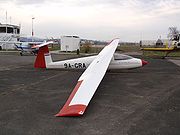
PZL Bielsko SZD-30
Encyclopedia
{
The SZD-30 Pirat is a single-seat multi-purpose glider aircraft
from the Polish
firm PZL Bielsko, which first flew in 1966 and was produced beginning in 1967.
on both upper and lower surfaces. The inner section of the wing is constant-chord and the outer section is tapered.
The forward section of the otherwise all-wood fuselage is made of fiberglass
. The single-wheel main landing gear is fixed. The formed one-piece canopy is side-mounted. The fuselage can be equipped with radios and oxygen system. There are two baggage compartments. Water ballast is not available.

The SZD-30 Pirat is a single-seat multi-purpose glider aircraft
Glider aircraft
Glider aircraft are heavier-than-air craft that are supported in flight by the dynamic reaction of the air against their lifting surfaces, and whose free flight does not depend on an engine. Mostly these types of aircraft are intended for routine operation without engines, though engine failure can...
from the Polish
Poland
Poland , officially the Republic of Poland , is a country in Central Europe bordered by Germany to the west; the Czech Republic and Slovakia to the south; Ukraine, Belarus and Lithuania to the east; and the Baltic Sea and Kaliningrad Oblast, a Russian exclave, to the north...
firm PZL Bielsko, which first flew in 1966 and was produced beginning in 1967.
Development
The SZD-30 is of wooden construction. The high-mounted wing incorporates air brakesAir brake (aircraft)
In aeronautics, air brakes or speedbrakes are a type of flight control surface used on an aircraft to increase drag or increase the angle of approach during landing....
on both upper and lower surfaces. The inner section of the wing is constant-chord and the outer section is tapered.
The forward section of the otherwise all-wood fuselage is made of fiberglass
Fiberglass
Glass fiber is a material consisting of numerous extremely fine fibers of glass.Glassmakers throughout history have experimented with glass fibers, but mass manufacture of glass fiber was only made possible with the invention of finer machine tooling...
. The single-wheel main landing gear is fixed. The formed one-piece canopy is side-mounted. The fuselage can be equipped with radios and oxygen system. There are two baggage compartments. Water ballast is not available.
Variants
- SZD-30 - initial production version, with fully balanced ailerons
- SZD-30B - a single prototype
- SZD-30C - later production version, with smaller partially balanced ailerons of fiberglass, and larger cockpit. The first -30C flew on 10 January 1978.
Specifications


